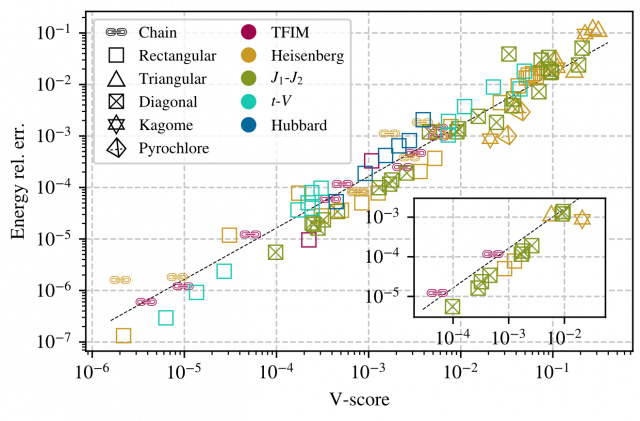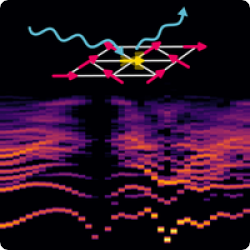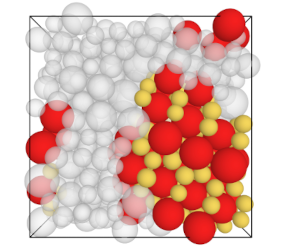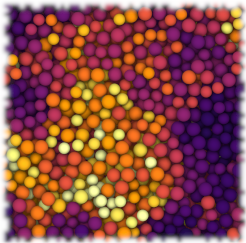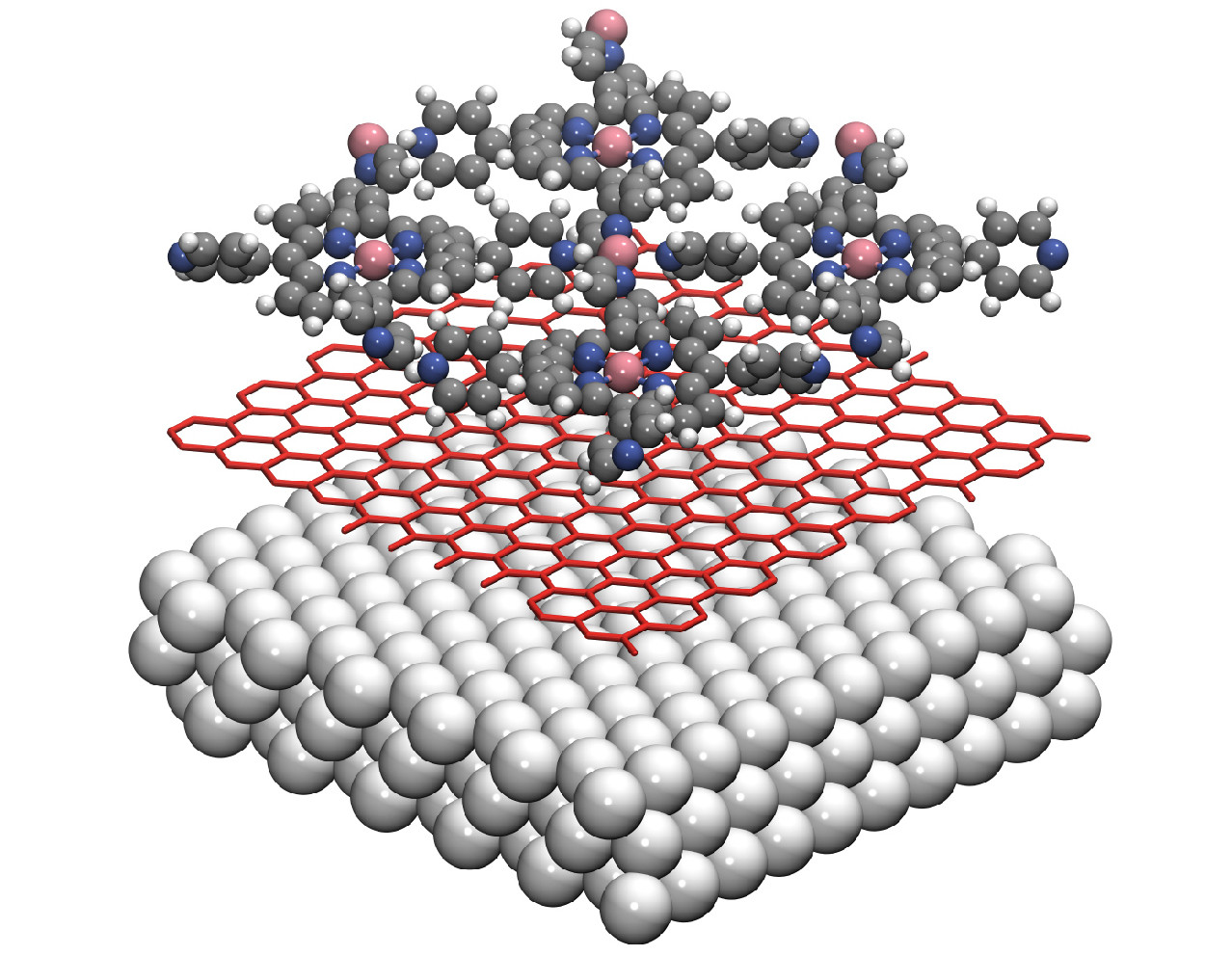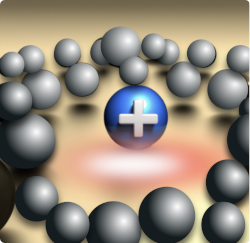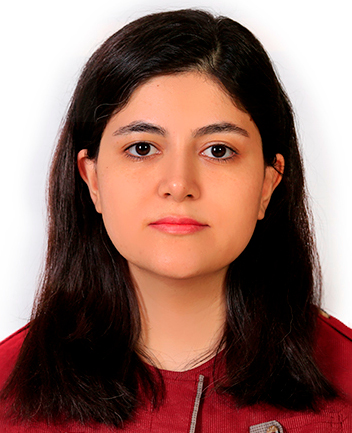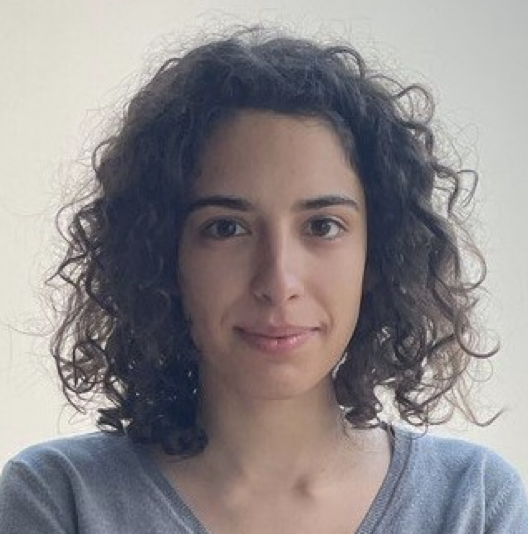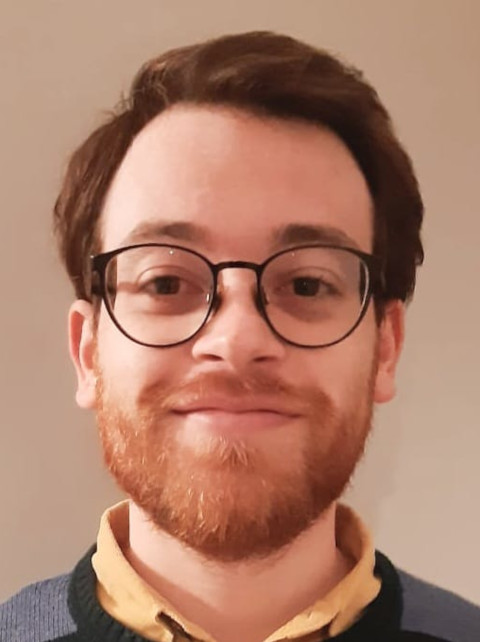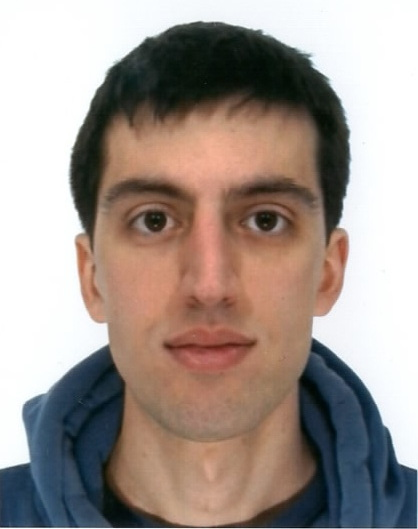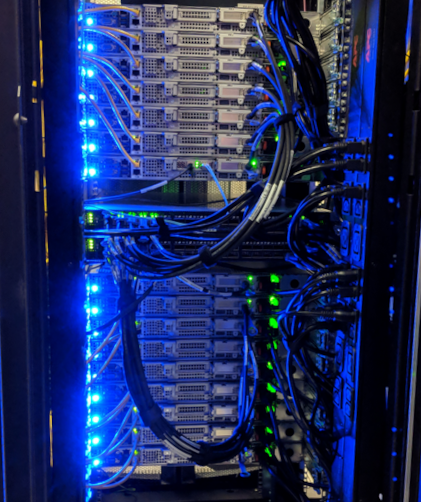"Interaction-induced phases in the half-filled Bernevig-Hughes-Zhang model in one dimension"
Roberta Favata, Davide Piccioni, Alberto Parola, Federico Becca
Phys. Rev. B 111, 155105 (2025)
We explore the ground-state properties of a one-dimensional model with two orbitals per site, where, in addition to atomic energies $\pm M$, intra- and inter-orbital hoppings, the intra-orbital Hubbard ($U$) and nearest-neighbor density-density ($V$) repulsions are included. Our results are primarily based on a Jastrow-Slater wave function and variational Monte Carlo methods, but also corroborated by density-matrix renormalization group calculations. In the non-interacting limit, when varying $M>0$, a gapless point separates a trivial phase from a topological one. The inclusion of a finite Hubbard-$U$ repulsion does not give rise to any phase transition within the topological region, inducing a smooth crossover into a Haldane (spin gapped) insulator; notably, the string-order parameter, which characterizes the latter phase, is already finite in the non-interacting limit. Most importantly, at finite values of $U$, the transition between the trivial and topological states is not direct, since an emergent insulator, which shows evidence of sustaining gapless spin excitations, intrudes between them. A small $V$ interaction further stabilizes the intermediate insulator, while a sufficiently large value of this nearest-neighbor repulsion gives rise to two different charge-density wave insulators, one fully gapped and another still supporting gapless spin excitations. Our results demonstrate the richness of multi-orbital Hubbard models, in the presence of a topologically non-trivial band structure, and serve as a basis for future investigations on similar two-dimensional models.
"Insulating and metallic phases in the one-dimensional Hubbard-Su-Schrieffer-Heeger model: Insights from a backflow-inspired variational wave function"
Davide Piccioni, Francesco Ferrari, Michele Fabrizio, Federico Becca
Phys. Rev. B 111, 045125 (2025)
The interplay between electron-electron and electron-phonon interactions is studied in a one-dimensional lattice model, by means of a variational Monte Carlo method based on generalized Jastrow-Slater wave functions. Here, the fermionic part is constructed by a pair-product state, which explicitly depends on the phonon configuration, thus including the electron-phonon coupling in a backflow-inspired way. We report the results for the Hubbard model in presence of the Su-Schrieffer-Heeger coupling to optical phonons, both at half-filling and upon hole doping. At half-filling, the ground state is either a translationally invariant Mott insulator, with gapless spin excitations, or a Peierls insulator, which breaks translations and has fully gapped excitations. Away from half-filling, the charge gap closes in both Mott and Peierls insulators, turning the former into a conventional Luttinger liquid (gapless in all excitation channels). The latter, instead, retains a finite spin gap that closes only above a threshold value of the doping. Even though consistent with the general theory of interacting electrons in one dimension, the existence of such a phase (with gapless charge but gapped spin excitations) has never been demonstrated in a model with repulsive interaction and with only two Fermi points. Since the spin-gapped metal represents the one-dimensional counterpart of a superconductor, our results furnish evidence that a true off-diagonal long-range order may exist in the two-dimensional case.
"Intertwined superconductivity and orbital selectivity in a three-orbital Hubbard model for the iron pnictides"
Vito Marino, Alberto Scazzola, Federico Becca, Massimo Capone, Luca F. Tocchio
Phys. Rev. Lett. 134, 196502 (2025)
We study a three-orbital Hubbard-Kanamori model relevant for iron-based superconductors using variational wave functions explicitly including spatial correlations and electron pairing. We span the nonmagnetic sector from filling $n=4$, which is representative of undoped iron-based superconductors, to $n=3$, where a Mott insulating state with each orbital at half filling is found. In the strong-coupling regime, when the electron density is increased, we find a spontaneous differentiation between the occupation of $d_{xz}$ and $d_{yz}$ orbitals, leading to an orbital-selective state with a nematic character that becomes stronger at increasing density. One of these orbitals stays half-filled for all densities while the other one hosts (together with the $d_{xy}$ orbital) the excess of electron density. Most importantly, in this regime long-range pairing correlations appear in the orbital with the largest occupation. Our results highlight a strong link between orbital-selective correlations, nematicity, and superconductivity, which requires the presence of a significant Hund's coupling.
"Monopole excitations in the $U(1)$ Dirac spin liquid on the triangular lattice"
Sasank Budaraju, Alberto Parola, Yasir Iqbal, Federico Becca, Didier Poilblanc
Phys. Rev. B 111, 125150 (2025)
The $U(1)$ Dirac spin liquid might realize an exotic phase of matter whose low-energy properties are described by quantum electrodynamics in $2+1$ dimensions, where gapless modes exists but spinons and gauge fields are strongly coupled. Its existence has been proposed in frustrated Heisenberg models in presence of frustrating super-exchange interactions, by the (Abrikosov) fermionic representation of the spin operators [X.-G. Wen, \href{https://doi.org/10.1103/PhysRevB.65.165113}{Phys. Rev. B {\bf 65}, 165113 (2002)}], supplemented by the Gutzwiller projection. Here, we construct charge-$Q$ monopole excitations in the Heisenberg model on the triangular lattice with nearest- ($J_1$) and next-neighbor ($J_2$) couplings. In the highly frustrated regime, singlet and triplet monopoles with $Q=1$ become gapless in the thermodynamic limit; in addition, the energies for generic $Q$ agree with field-theoretical predictions, obtained for a large number of gapless fermion modes. Finally, we consider localized gauge excitations, in which magnetic $π$-fluxes are concentrated in the triangular plaquettes (in analogy with $\mathbb{Z}_2$ visons), showing that these kind of states do not play a relevant role at low energies. All our findings lend support to a stable $U(1)$ Dirac spin liquid in the $J_1-J_2$ Heisenberg model on the triangular lattice.
"Transformer Wave Function for two dimensional frustrated magnets: emergence of a Spin-Liquid Phase in the Shastry-Sutherland Model"
Luciano Loris Viteritti, Riccardo Rende, Alberto Parola, Sebastian Goldt, Federico Becca
Phys. Rev. B 111, 134411 (2025)
Understanding quantum magnetism in two-dimensional systems represents a lively branch in modern condensed-matter physics. In the presence of competing super-exchange couplings, magnetic order is frustrated and can be suppressed down to zero temperature. Still, capturing the correct nature of the exact ground state is a highly complicated task, since energy gaps in the spectrum may be very small and states with different physical properties may have competing energies. Here, we introduce a variational Ansatz for two-dimensional frustrated magnets by leveraging the power of representation learning. The key idea is to use a particular deep neural network with real-valued parameters, a so-called Transformer, to map physical spin configurations into a high-dimensional feature space. Within this abstract space, the determination of the ground-state properties is simplified and requires only a shallow output layer with complex-valued parameters. We illustrate the efficacy of this variational Ansatz by studying the ground-state phase diagram of the Shastry-Sutherland model, which captures the low-temperature behavior of SrCu$_2$(BO$_3$)$_2$ with its intriguing properties. With highly accurate numerical simulations, we provide strong evidence for the stabilization of a spin-liquid between the plaquette and antiferromagnetic phases. In addition, a direct calculation of the triplet excitation at the $Γ$ point provides compelling evidence for a gapless spin liquid. Our findings underscore the potential of Neural-Network Quantum States as a valuable tool for probing uncharted phases of matter, and open up new possibilities for establishing the properties of many-body systems.
"Foundation Neural-Networks Quantum States as a Unified Ansatz for Multiple Hamiltonians"
Riccardo Rende, Luciano Loris Viteritti, Federico Becca, Antonello Scardicchio, Alessandro Laio et al.
Nature Communications 16, 7213 (2025)
Foundation models are highly versatile neural-network architectures capable of processing different data types, such as text and images, and generalizing across various tasks like classification and generation. Inspired by this success, we propose Foundation Neural-Network Quantum States (FNQS) as an integrated paradigm for studying quantum many-body systems. FNQS leverage key principles of foundation models to define variational wave functions based on a single, versatile architecture that processes multimodal inputs, including spin configurations and Hamiltonian physical couplings. Unlike specialized architectures tailored for individual Hamiltonians, FNQS can generalize to physical Hamiltonians beyond those encountered during training, offering a unified framework adaptable to various quantum systems and tasks. FNQS enable the efficient estimation of quantities that are traditionally challenging or computationally intensive to calculate using conventional methods, particularly disorder-averaged observables. Furthermore, the fidelity susceptibility can be easily obtained to uncover quantum phase transitions without prior knowledge of order parameters. These pretrained models can be efficiently fine-tuned for specific quantum systems. The architectures trained in this paper are publicly available at https://huggingface.co/nqs-models, along with examples for implementing these neural networks in NetKet.
-
We reassess the modeling of amorphous silica bilayers as a two-dimensional classical system whose particles interact with an effective pairwise potential. We show that it is possible to reparameterize the potential developed by Roy, Heyde, and Heuer to quantitatively match the structural details of the experimental samples. We then study the glassy dynamics of the reparameterized model at low temperatures. Using appropriate cage-relative correlation functions, which suppress the effect of Mermin-Wagner fluctuations, we highlight the presence of two well-defined Arrhenius regimes separated by a narrow crossover region, which we connect to the thermodynamic anomalies and the changes in the local structure. We find that the bond-orientational order grows steadily below the crossover temperature and is associated to transient crystalline domains of nanometric size. These findings raise fundamental questions about the nature of glass structure in two dimensions and provide guidelines to interpret the experimental data.
-
We clarify the relationship between freezing, melting, and the onset of glassy dynamics in a prototypical glass-forming mixture model. Our starting point is a precise operational definition of the onset of glassiness, as expressed by the emergence of inflections in time-dependent correlation functions. By scanning the temperature-composition phase diagram of the mixture, we find a disconnect between the onset of glassiness and freezing. Surprisingly, however, the onset temperature closely tracks the melting line, along which the excess entropy is approximately constant. At fixed composition, all characteristic temperatures display nonetheless similar pressure dependencies, which are very well predicted by the isomorph theory. While our results rule out a general connection between thermodynamic metastability and glassiness, they call for a reassessment of the role of crystalline precursors in glass-forming liquids.
"Roadmap on machine learning glassy dynamics"
Gerhard Jung, Rinske M. Alkemade, Victor Bapst, Daniele Coslovich, Laura Filion et al.
Nat. Rev. Phys. 7, 91 (2025)
Unraveling the connections between microscopic structure, emergent physical properties, and slow dynamics has long been a challenge when studying the glass transition. The absence of clear visible structural order in amorphous configurations complicates the identification of the key physical mechanisms underpinning slow dynamics. The difficulty in sampling equilibrated configurations at low temperatures hampers thorough numerical and theoretical investigations. This perspective article explores the potential of machine learning (ML) techniques to face these challenges, building on the algorithms that have revolutionized computer vision and image recognition. We present recent successful ML applications, as well as many open problems for the future, such as transferability and interpretability of ML approaches. We highlight new ideas and directions in which ML could provide breakthroughs to better understand the fundamental mechanisms at play in glass-forming liquids. To foster a collaborative community effort, this article also introduces the ``GlassBench" dataset, providing simulation data and benchmarks for both two-dimensional and three-dimensional glass-formers. We propose critical metrics to compare the performance of emerging ML methodologies, in line with benchmarking practices in image and text recognition. The goal of this roadmap is to provide guidelines for the development of ML techniques in systems displaying slow dynamics, while inspiring new directions to improve our theoretical understanding of glassy liquids.
"Spin-phonon interactions on the kagome lattice: Dirac spin liquid versus valence-bond solids"
Francesco Ferrari, Federico Becca, Roser Valenti
Phys. Rev. B 109, 165133 (2024)
We investigate the impact of the spin-phonon coupling on the S=1/2 Heisenberg model on the kagome lattice. For the pure spin model, there is increasing evidence that the low-energy properties can be correctly described by a Dirac spin liquid, in which spinons with a conical dispersion are coupled to emergent gauge fields. Within this scenario, the ground-state wave function is well approximated by a Gutzwiller-projected fermionic state [Y. Ran, M. Hermele, P.A. Lee, and X.-G. Wen, Phys. Rev. Lett. 98, 117205 (2007)]. However, the existence of U(1) gauge fields may naturally lead to instabilities when small perturbations are included. Since phonons are ubiquitous in real materials, they may play a relevant role in the determination of the actual physical properties of the kagome antiferromagnet. We perform a step forward in this direction, including phonon degrees of freedom (at the quantum level) and applying a variational approach based upon Gutzwiller-projected fermionic Ansätze. Our results suggest that the Dirac spin liquid is stable for small spin-phonon couplings, while valence-bond solids are obtained at large couplings. Even though different distortions can be induced by the spin-phonon interaction, the general aspect is that the energy is lowered by maximizing the density of perfect hexagons in the dimerization pattern.
-
Recent progress in the design and optimization of neural-network quantum states (NQSs) has made them an effective method to investigate ground-state properties of quantum many-body systems. In contrast to the standard approach of training a separate NQS from scratch at every point of the phase diagram, we demonstrate that the optimization of a NQS at a highly expressive point of the phase diagram (i.e., close to a phase transition) yields features that can be reused to accurately describe a wide region across the transition. We demonstrate the feasibility of our approach on different systems in one and two dimensions by initially pretraining a NQS at a given point of the phase diagram, followed by fine-tuning only the output layer for all other points. Notably, the computational cost of the fine-tuning step is very low compared to the pretraining stage. We argue that the reduced cost of this paradigm has significant potential to advance the exploration of strongly-correlated systems using NQS, mirroring the success of fine-tuning in machine learning and natural language processing.
"A simple linear algebra identity to optimize Large-Scale Neural Network Quantum States"
Riccardo Rende, Luciano Loris Viteritti, Lorenzo Bardone, Federico Becca, Sebastian Goldt
Communications Physics 7, 260 (2024)
Neural-network architectures have been increasingly used to represent quantum many-body wave functions. These networks require a large number of variational parameters and are challenging to optimize using traditional methods, as gradient descent. Stochastic Reconfiguration (SR) has been effective with a limited number of parameters, but becomes impractical beyond a few thousand parameters. Here, we leverage a simple linear algebra identity to show that SR can be employed even in the deep learning scenario. We demonstrate the effectiveness of our method by optimizing a Deep Transformer architecture with $3 \times 10^5$ parameters, achieving state-of-the-art ground-state energy in the $J_1$-$J_2$ Heisenberg model at $J_2/J_1=0.5$ on the $10\times10$ square lattice, a challenging benchmark in highly-frustrated magnetism. This work marks a significant step forward in the scalability and efficiency of SR for Neural-Network Quantum States, making them a promising method to investigate unknown quantum phases of matter, where other methods struggle.
"Variational Benchmarks for Quantum Many-Body Problems"
Dian Wu, Riccardo Rossi, Filippo Vicentini, Nikita Astrakhantsev, Federico Becca et al.
Science 386, 296-301 (2024)
The continued development of computational approaches to many-body ground-state problems in physics and chemistry calls for a consistent way to assess its overall progress. In this work, we introduce a metric of variational accuracy, the V-score, obtained from the variational energy and its variance. We provide an extensive curated dataset of variational calculations of many-body quantum systems, identifying cases where state-of-the-art numerical approaches show limited accuracy, and future algorithms or computational platforms, such as quantum computing, could provide improved accuracy. The V-score can be used as a metric to assess the progress of quantum variational methods toward a quantum advantage for ground-state problems, especially in regimes where classical verifiability is impossible.
"Policy-guided Monte Carlo on general state spaces: Application to glass-forming mixtures"
Leonardo Galliano, Riccardo Rende, Daniele Coslovich
J. Chem. Phys. 161, 064503 (2024)
Policy-guided Monte Carlo is an adaptive method to simulate classical interacting systems. It adjusts the proposal distribution of the Metropolis-Hastings algorithm to maximize the sampling efficiency, using a formalism inspired by reinforcement learning. In this work, we first extend the policy-guided method to deal with a general state space, comprising, for instance, both discrete and continuous degrees of freedom, and then apply it to a few paradigmatic models of glass-forming mixtures. We assess the efficiency of a set of physically inspired moves whose proposal distributions are optimized through on-policy learning. Compared to conventional Monte Carlo methods, the optimized proposals are two orders of magnitude faster for an additive soft sphere mixture but yield a much more limited speed-up for the well-studied Kob-Andersen model. We discuss the current limitations of the method and suggest possible ways to improve it.
-
We study the quasiparticle properties of a dipolar impurity immersed in a two-dimensional dipolar bath. We use the ab-initio Diffusion Monte Carlo technique to determine the polaron energy, effective mass and quasiparticle residue. We find that both the polaron energy and quasiparticle residue follow a universal behaviour with respect to the polarization angle when properly scaled in terms of the scattering length. This trend is maintained over a wide range of values of the gas parameter, even in the highly correlated regime. Instead, the effective mass shows growing anisotropy as the tilting angle is increased, which is induced, mainly, by the anisotropy of the impurity-boson dipole-dipole interaction. Surprisingly, the effective mass is larger in the direction of minimum inter-particle repulsion. Finally, we use our Monte Carlo results to check the accuracy of perturbative approaches and determine their range of validity in terms of the gas parameter.
"Modified mean field ansatz for charged polarons in a Bose-Einstein condensate"
Ubaldo Cavazos Olivas, Luis A. Peña Ardila, Krzysztof Jachymski
Phys. Rev. A 110, L011301 (2024)
Ionic Bose polarons are quantum entities emerging from the interaction between an ion and a Bose-Einstein condensate (BEC), featuring long-ranged interactions that can compete with the gas healing length. This can result in strong interparticle correlations and enhancement of gas density around the ion. One possible approach to describe this complex system with high accuracy relies on numerical treatment such as the quantum Monte Carlo (QMC) techniques. Nevertheless, it is computationally very expensive and does not easily allow to study the system dynamics. On the other hand, a mean-field based variational ansatz in the co-moving frame can capture a sizeable change in the gas density. We apply it to the case of regularized ion-atom potential and find that it qualitatively reproduces the full numerical results. In addition, we also study the system of two pinned ions, focusing on their effective interaction induced by the bath. This approach seems to be promising for studying transport and nonequilibrium dynamics of charged (bi)polarons in condensed media.
-
We study the quasiparticle properties of a dipolar impurity immersed in a two-dimensional dipolar bath. We use the ab-initio Diffusion Monte Carlo technique to determine the polaron energy, effective mass and quasiparticle residue. We find that both the polaron energy and quasiparticle residue follow a universal behaviour with respect to the polarization angle when properly scaled in terms of the scattering length. This trend is maintained over a wide range of values of the gas parameter, even in the highly correlated regime. Instead, the effective mass shows growing anisotropy as the tilting angle is increased, which is induced, mainly, by the anisotropy of the impurity-boson dipole-dipole interaction. Surprisingly, the effective mass is larger in the direction of minimum inter-particle repulsion. Finally, we use our Monte Carlo results to check the accuracy of perturbative approaches and determine their range of validity in terms of the gas parameter.
"Modified mean field ansatz for charged polarons in a Bose-Einstein condensate"
Ubaldo Cavazos Olivas, Luis A. Peña Ardila, Krzysztof Jachymski
Phys. Rev. A 110, L011301 (2024)
Ionic Bose polarons are quantum entities emerging from the interaction between an ion and a Bose-Einstein condensate (BEC), featuring long-ranged interactions that can compete with the gas healing length. This can result in strong interparticle correlations and enhancement of gas density around the ion. One possible approach to describe this complex system with high accuracy relies on numerical treatment such as the quantum Monte Carlo (QMC) techniques. Nevertheless, it is computationally very expensive and does not easily allow to study the system dynamics. On the other hand, a mean-field based variational ansatz in the co-moving frame can capture a sizeable change in the gas density. We apply it to the case of regularized ion-atom potential and find that it qualitatively reproduces the full numerical results. In addition, we also study the system of two pinned ions, focusing on their effective interaction induced by the bath. This approach seems to be promising for studying transport and nonequilibrium dynamics of charged (bi)polarons in condensed media.


